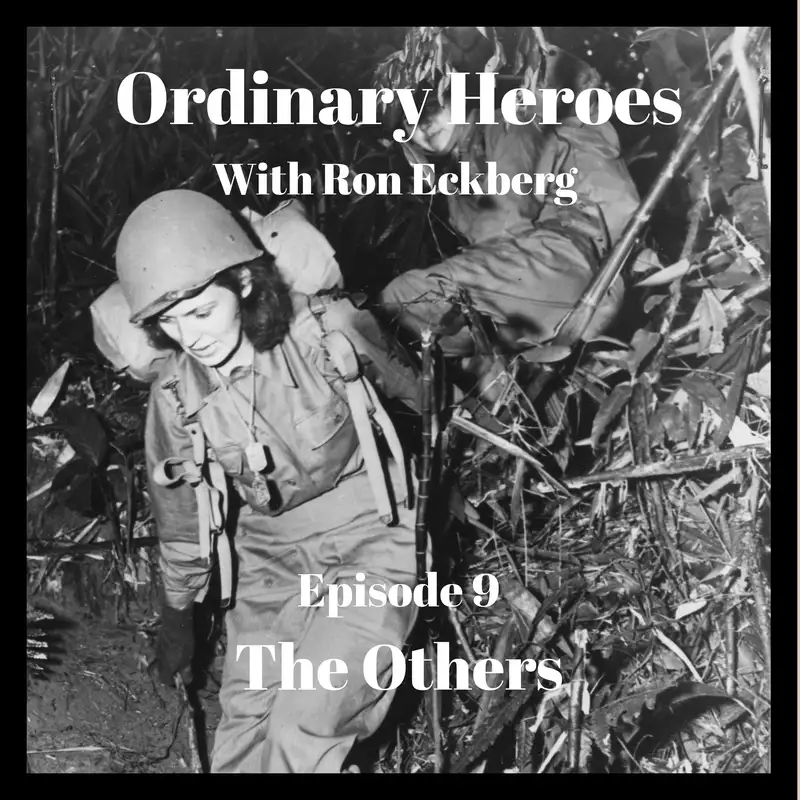The Others
They were young women, some barely in their 20s, all having grown up with simple dreams for a simpler time.
Then came the war and all that changed.
Until recently their stories have remained largely unknown, lost within the many combat books and movies that focused on the men in combat in the midst of the combat. Their stories are intriguing, powerful, however. And must not be forgotten.
One example can be found in a series of letters written by a young Army nurse from Battle Creek, Michigan named June Wandrey. Published in Andrew Carroll’s book, War Letters, the letters serve as a poignant reminder of how our definitions of heroes and heroism may be limited at best.
Wandrey’s first letter was written from somewhere in Italy in February 1944. She describes what it’s like to be an army nurse fighting for the lives of the wounded while putting her own at great risk. In addition, she and her fellow nurses and doctors fought numbing cold, rain and snow, constant German shelling, and, the worst of all; the stress of seeing young men you have tried to save die before your very eyes.
“The Germans bombed and straffed a hospital on the beachhead a few days ago”, Wandrey wrote, “… reports listed 23 dead and 68 wounded.“
Then she adds, “The dead included two nurses, six patients, 14 of the hospital personnel, and a Red Cross worker.“
She goes on to describe how the dead included so many already wounded and awaiting treatment, how the enemy dropped fragmentation bombs on the clearly marked operating and administrative tents, and how litter bearers were hit by fragments yet continued to try to get their patient to the aid tent until their wounds made their task impossible.
Wandrey spent 2 1/2 years overseas and somehow survived the terrible conditions and dangers of war. Yet she would become one of war’s victims in another all too common way. In another letter, reprinted in Carroll’s book, her boyfriend wrote to tell her that he had found another woman. Her response was amazingly heroic yet painful.
“In spirit,” she wrote to her parents, “I joined the Legion of soldiers in ETO who received a dear John letter. ‘Love postponed on account of war’ became my battle cry.”
Wandrey was not alone in her service and sacrifice, or course.
One of the many American Military Cemeteries in Europe offer us not one but four stories.
In the Normandy American Cemetery and Memorial in Colleville, France, on the bluffs above the beach immortalized as Omaha Beach, you will find 9,384 white Lasa Marble crosses and Stars of David, each marking the final resting place of an American Serviceman.
You will also find four more marking the graves of American women killed in France and laid to rest in that cemetery. Mary Bankston, Mary Barlow, Dolores Browne, all servicewomen and Elizabeth Richardson, an American Red Cross worker, all died in France in 1945. Their families chose to have them buried with the men they had volunteered to serve with.
Bankston, Barlow, and Browne were part of the “Six Triple Eight” Central Postal Directory Battalion working to make sure the much needed and welcomed mail from home was delivered to the troops. It may not have been frontline combat but the work was crucial nontheless. Mail from home was vitally important for maintaining morale among the troops. Bankston and Barlow helped in the morale department in another way, serving in the battalion’s entertainment troupe, putting on performances for the soldiers in their spare time.
The “Three ‘Bs” as they were known died as the result of a Jeep crash on July 8, 1945. Bankston and Barlow were killed instantly in the accident while Browne survived for five days before succumbing to her wounds.
Richardson, the only non-military member of the four women, died on July 25, 1945 when the small plane she was a passenger in crashed near Rouen, France killing both her and her pilot.
The “three Bs”—Mary Bankston, Mary Barlow, and Dolores Browne—as well as Elizabeth Richardson may not have been killed by enemy fire but all four gave their lives in the service of our country and deserve their place among the others in the Colleville cemetery.
So sacrifice was not just a quality reserved for just red blooded American boys nor was sheer heroism reserved for the combat soldiers on the frontlines.
Take for example the story of one of the most celebrated woman war heroes of World War II, Aleda Lutz.
Lutz grew up in Michigan then looked forward to a career in the medical field. After graduating from nursing school in 1937 she began a private nursing practice.
Then came the war.
As the need for medical personnel intensified Lutz responded to the call and on February 10, 1942 sh enlisted in the Army Air Forces Nurse Corp. Ultimately she found herself in the European Theater with the 802nd Medical Air Evacuation Squadron flying in a C-47 to the battlefield with supplies then bring wounded soldiers and POWs out on the return trip.
On November 1, 1944 Lutz was on a Medieval C-47 transporting wounded soldiers from Lyon, France to a hospital in Italy when the weather conditions rapidly deteriorated. In the worsening conditions the pilot of Lutz’s plane lost control and the plane crashed near St. Chamond, France leaving no survivors.
Amazingly, it was Lutz’s 196th evacuation or transportation mission.
For her faithful and sacrificial service Lutz was awarded the Distinguished Flying Cross, the first to be given to an Army Nurse in World War II. Her citation reads in part;
“For extraordinary achievement while participating in aerial flight as a flight nurse of a C-47aircraft. Throughout her long period of service Lt. Lutz distinguished herself through her professional skill and courage. Flying on more than 190 missions to evacuate wounded from forward areas, Lt. Lutz’s resourcefulness and determination have been of high aspiration to those serving with her. Her selfless devotion to duty and outstanding proficiency have reflected the highest credit upon herself and the Armed Forces of the United States.”
There is yet one more story for us to look to as we see the amazing heroism and contribution World War II made by the “others”.
It is the story of true courage under fire. It is the story of Ellen G. Ainsworth.
In late 1943 Ainsworth, a Wisconsin native, found herself in Anzio, Italy as part of the 56th Evacuation Hospital. Their hospital and grounds were nicknamed, “A half acre of Hell” and often was so close to the fighting that wounded men could walk to the hospital if their wounds allowed.
As Christmas 1943 approached Ainsworth penned a poem that would be published in the local paper. It reads;
My home is a tent,
I sleep on a cot,
You have snow
But we have not.
This note brings greetings,
From far to near.
To all those beings
That I hold dear.
Season’s greetings through the year.
And, contrary to custom,
“I’m glad you’re not here.”
Anzio was a vicious battle that raged for over four months and cost the Allies dearly. 7,000 would lose their lives while another 36,000 (many non-combat related) would be recorded. Ainsworth was among those who cared for the wounded, patients she would refer to as “her boys”.
Being so close to the combat lines the hospital was subject to constant shelling. One heavy bombardment came on February 10, 1944. A later citation would describe her actions under fire.
"Second Lieutenant Ainsworth was on duty in a hospital ward, while the area was being subjected to heavy enemy artillery shelling. One shell dropped within a few feet of the ward, its fragments piercing the tent in numerous places. Despite the extreme danger, she calmly directed the placing of (42) surgical patients on the ground to lessen the danger of further injury. By her disregard for her own safety and her calm assurance, she instilled confidence in her assistants and her patients, thereby preventing serious panic and injury,”
Two days later, the heaviest attack would come. While other personnel were working furiously to get patients into a makeshift shelter, Ainsworth stayed behind to care for those remaining. The first bombs fell in an attack that would last an hour and a half.
One shell landed just outside the tent where Ainsworth was tirelessly working to put 42 patients in a place of relative safety under their beds. A fragment of the shell pierced her chest. Still, she kept at the task of caring for “her boys”. Finally, she was evacuated. As she was carried away she commented to her fellow nurses that, “Nothing these Krauts can do can scare us at this point.”
Four days after the attack that left her wounded, Ellen Ainsworth died. She was 24 years old.
Her heroism would not go unnoticed. Awards and citations piled up, most notably the Red Cross Bronze Medal and the Purple Heart with Oak Leaf Cluster.
She would also become only the fourth Army woman to be awarded the Silver Star, given to those who show exceptional courage under fire. Her citation reads, in part;
“Second Lieutenant Ainsworth's gallant actions and dedicated devotion to duty, without regard for her own life, were in keeping with the highest traditions of military service and reflect great credit upon herself, her unit, and the United States Army.”
June Wandry. The “Three B’s”. Elizabeth Richardson. Aleda Lutz. Ellen Ainsworth. Just seven women from among the 350,000 women who served in World War II. They did invaluable service. They suffered as they watched other suffer. Some gave their lives in the line of fire.
In so many ways they are just now receiving the appreciation they so richly deserve. These seven women’s stories are just the tip of the iceberg, however. There are so many more.
In the June 4th, 2024 issue of the military publication, Stars and Strips, American Battle Monument’s Commission secretary, Charles Djou added an important note.
“It’s important to remember that sacrifice came from all corners of America,” he said, “It wasn’t just soldiers who made the ultimate sacrifice for our nation.”
In the same Stars and Strips article, Kim Guise, a senior curator at the National World War II Museum in New Orleans adds, “It’s wonderful that many Americans know about Rosie the Riveter and the important work that women were doing in factories, here on the homefront but a lot of people don’t realize that women served in such large numbers in the military during World War II.”
Then Guise adds, “There are some stories that are very well-known from World War II and for good reason, but if you look below the surface just a little, there are these other individuals and other stories that are just waiting to be told.”
That’s what this podcast is designed to do—uncover the untold, uncelebrated stories of World War II and help keep them alive for future generations. Let’s not forget them.
Let’s not forget the “others”

